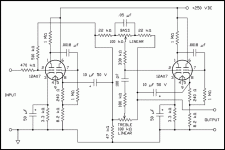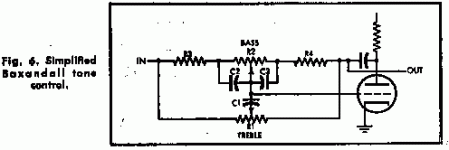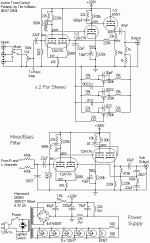The schematic can be found on Max Robinson's "Fun with Tubes" web site, with a detailed explanation.
You can see it at: http://www.angelfire.com/electronic/funwithtubes/Amp-Tone.html
Max says he has built it and was quite impressed with its performance.
Regards,
Ray
You can see it at: http://www.angelfire.com/electronic/funwithtubes/Amp-Tone.html
Max says he has built it and was quite impressed with its performance.
Regards,
Ray
I'm abit far away from my library so can't post a schematic, but... in Glass Audio a few years back, there was a circuit for a tube version of the tilt circuit that Quad popularized (this tube version was adapted from a Reg Williamson circuit). Of all the tone controls I've used, the tilt control has been the most effective.
In the adaption, a pentode (5879?) was used, but there's no reason one couldn't use cascaded or cascoded triodes.
In the adaption, a pentode (5879?) was used, but there's no reason one couldn't use cascaded or cascoded triodes.
ray_moth said:The schematic can be found on Max Robinson's "Fun with Tubes" web site, with a detailed explanation.
You can see it at: http://www.angelfire.com/electronic/funwithtubes/Amp-Tone.html
Max says he has built it and was quite impressed with its performance.
Regards,
Ray
Gee, thanks for the link! So that's where it came from. 🙂
SY said:I'm abit far away from my library so can't post a schematic, but... in Glass Audio a few years back, there was a circuit for a tube version of the tilt circuit that Quad popularized (this tube version was adapted from a Reg Williamson circuit). Of all the tone controls I've used, the tilt control has been the most effective.
In the adaption, a pentode (5879?) was used, but there's no reason one couldn't use cascaded or cascoded triodes.
I would be very happy if you could please post a schematic of that circuit. I don't have a 5879 tube but only 12AX7 and 12AU7 I have readily. I guess it can be reconfigured to accept this tubes.
JojoD
That circuit looks a hell of a lot like a Baxandall tone control.
I would highly recomend this circuit. I have used a passive version of the Baxandall circuit before, and it has very impressive results, offering a very wide range of tonal variations considering just two controls, bass and treble... and set bass and trebble both in the middle, and in theory you're getting a completly flat frequency response from the circuit.
i attached a schematic from an old article i have that is acutually about anode followers... but it discusses Baxandall's tone control in there as this utilises an anode follower, so therefore, in the article, there was provided this highly simplified version of a Baxandall tone control.
I say you should build it... my 2 cents
cheers
I would highly recomend this circuit. I have used a passive version of the Baxandall circuit before, and it has very impressive results, offering a very wide range of tonal variations considering just two controls, bass and treble... and set bass and trebble both in the middle, and in theory you're getting a completly flat frequency response from the circuit.
i attached a schematic from an old article i have that is acutually about anode followers... but it discusses Baxandall's tone control in there as this utilises an anode follower, so therefore, in the article, there was provided this highly simplified version of a Baxandall tone control.
I say you should build it... my 2 cents
cheers
Attachments
JojoD818 said:
I would be very happy if you could please post a schematic of that circuit. I don't have a 5879 tube but only 12AX7 and 12AU7 I have readily. I guess it can be reconfigured to accept this tubes.
JojoD
I hope someone else can- I won't be back home until the first week in July...
You can't substitute in directly a 12AX7, but a pair in cascade should give you sufficient gain for the circuit to work properly.
Baxandall
You are absolutely right about the Baxandall. I have built circuits with Baxandall but using opamps, and now I am into tubes, I want to build one that has tubes as the amplifier. 🙂
I bet those articles would be interesting read, can you please send me a copy?
jojod818@yahoo.com
Regards,
JojoD
benny said:That circuit looks a hell of a lot like a Baxandall tone control.
I would highly recomend this circuit. I have used a passive version of the Baxandall circuit before, and it has very impressive results, offering a very wide range of tonal variations considering just two controls, bass and treble... and set bass and trebble both in the middle, and in theory you're getting a completly flat frequency response from the circuit.
i attached a schematic from an old article i have that is acutually about anode followers... but it discusses Baxandall's tone control in there as this utilises an anode follower, so therefore, in the article, there was provided this highly simplified version of a Baxandall tone control.
I say you should build it... my 2 cents
cheers
You are absolutely right about the Baxandall. I have built circuits with Baxandall but using opamps, and now I am into tubes, I want to build one that has tubes as the amplifier. 🙂
I bet those articles would be interesting read, can you please send me a copy?
jojod818@yahoo.com
Regards,
JojoD
I bet those articles would be interesting read, can you please send me a copy?
yes, it's pretty interesting... and i've just sent it then... enjoy.
cheers
benny said:
yes, it's pretty interesting... and i've just sent it then... enjoy.
cheers
I got the file, it is very helpful, thanks a lot!
I got the file, it is very helpful, thanks a lot!
yeah... you'd better be thankful, becuase it was sooooooooo much effort to send... not!
happy you found it to be useful. i think reading articles like that is where you find out a lot of the interesting things about tubes and in some cases, you see where a lot of common ideals have come from.
cheers
exactly my point. with electronics articles I learn how the circuit works, it guides me in prototyping and then imagination takes over. 🙂
You'll find that this (modern ?) circuit uses readily available 100k potentiometers for the controls. In order for the gain stages to drive the Baxandall filter with these values, the cathode follower buffer stages (right halves of the 12AX7's) are required.
In fact it is possible to build simplified versions of the circuit using single gain stages (e.g. 12AT7) if very large resistances and small capacitances are used in the Baxandall T-networks. For example the LEAK tone control circuits used 500k, 2M, 5M potentiometers which are hard to find today.
In fact it is possible to build simplified versions of the circuit using single gain stages (e.g. 12AT7) if very large resistances and small capacitances are used in the Baxandall T-networks. For example the LEAK tone control circuits used 500k, 2M, 5M potentiometers which are hard to find today.
Hi,
The tone controls are rather passive, no?
Cheers,😉
P.S. And no darn penthodes either...
I'll add my active preamp design then
The tone controls are rather passive, no?

Cheers,😉
P.S. And no darn penthodes either...

Well you can add motors and a remote to them if you must 
Woulda used pentodes but there aren't many dual input dual pentodes (don't think 6HS8 won't work) and I didn't feel like loading up on 7 pin tubes. 😉
Tim

Woulda used pentodes but there aren't many dual input dual pentodes (don't think 6HS8 won't work) and I didn't feel like loading up on 7 pin tubes. 😉
Tim
Tim,
This is not baxandall right? Are the tone controls located in what seem to be a feedback loop?
How does it sound?
JojoD
This is not baxandall right? Are the tone controls located in what seem to be a feedback loop?
How does it sound?
JojoD
It's just three controls, low mid and high. Still Baxandall, more or less, as far as I know. Just because it's active doesn't change the topology of the tone control.
Tim
Tim
Hi,
Not particularly...
I think Tim's idea is quite clever and should do all a tone control needs to do.
I'm still curious to see that tonecontrol from GA SY was talking about though.
Cheers,😉
Any tone control circuits you wanna share?
Not particularly...
I think Tim's idea is quite clever and should do all a tone control needs to do.
I'm still curious to see that tonecontrol from GA SY was talking about though.
Cheers,😉
- Status
- Not open for further replies.
- Home
- Amplifiers
- Tubes / Valves
- tube tone control?


